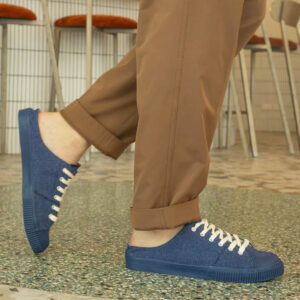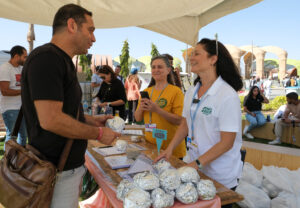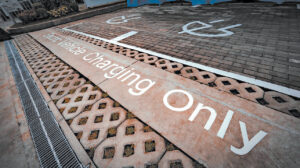Wearing piña on your feet

WHEN one thinks of pineapple fibers used in textile, we tend to associate it with stiff and formal Filipino formalwear. Beautiful, translucent, and terribly fragile, this cloth, called piña, isn’t worn often. But what if one can wear piña everyday?
The proposition of Creative Definitions, the entity behind brands Lakat and Aire, is a little bit different.
According to Creative Definitions co-founder Michael Claparols during this month’s Likhang Habi Fair in Glorietta, they use fibers not from the Red Spanish variety used for the delicate fabric, but the usually discarded leaves from the sweet Hawaiian variety. The fibers from their pineapple leaves are also mixed with cotton. Not quite piña, but still Filipino, and moreover, sustainable. The yarns spun from this process are made into sneakers (for Lakat; meaning “walk” in the Hiligaynon spoken in Negros from which Mr. Claparols hails), shirts, and pants (for Aire).
“It’s really the Negros Island region I’m trying to help,” he said. The resulting fabric is opaque, has a texture akin to linen, and is very receptive to dyeing. Mr. Claparols adds that the fabric is very breathable.
Mr. Claparols and his wife Banj support local farmers by buying the leaves from their pineapple plants, while they support other local communities through the other processes associated with making textiles: spinning, weaving, sewing, and so forth. Lakat’s sneakers, for example, are assembled in Rizal province, with the rubber soles sourced from Mindanao. He says that the only foreign things in the sneakers are the aglets and eyelets for the shoelaces (from Taiwan), and only because the ones available in the market weren’t up to standard.
Creative Definitions wasn’t always in the business of fibers: when they were founded in 2008, the Calaparols couple were simply trading Negros-made crafts. In 2017, they went on a trip to Hong Kong and were exposed to sustainable materials. They then went on to partner with a Negros weaving community, then entered discussions with the Department of Science and Technology – Philippine Textile Research Institute (DoST-PTRI) to create their own sustainable textile (where they learned the process at every step, so the Claparols could make their own cloth and clothes if asked).
According to Mr. Claparols, the PTRI already had the technology to process pineapple fiber, but had no way to commercialize it. Today, after the leaves have been stripped into fiber (by a solar-powered machine), the fibers are sent to PTRI to be blended with cotton and spun into yarn. Mr. Claparols hopes that in the future, a similar facility could be built in the Negros region, to reduce their carbon footprint. “One of the greatest strengths of the Philippines is our source of fibers. The challenge is how to convert them into something wearable,” he said.
Cool and consciousness come together in this shoe brand — while Mr. Claparols is joyful that more people are adopting sustainable lifestyles, he admits that in everyday life, the concepts aren’t always clear-cut. By designing clothes and shoes made from sustainable sources, he hopes to help close the gap. “The consciousness on that side, you can also put it in everyday use. That’s what I’m trying to grow,” he said.
We do note that the shoes cost P3,900 (and the shirts could go for more). Mr. Claparols pins this on the economies of scale: since his production is still on a smaller scale, he has no choice but to charge a bit higher for the operations to chug along smoothly. He hopes for more developments in the scene so entrepreneurs like him could increase production, and bring down prices: “If it’s not affordable, and if people don’t buy, it doesn’t become sustainable.” — Joseph L. Garcia




